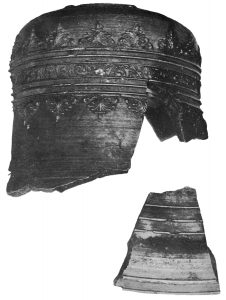Early Archaeological Investigation of Huronia and First Archaeological Investigations of Sainte Marie II
Late nineteenth- and early twentieth-century work on Ste. Marie II was conducted by archaeologists Andrew Hunter and Arthur Jones. Their efforts to track the locations of historic Wendat villages mentioned in ethnographic accounts, while also investigating sites and ossuaries reported to provincial authorities laid the foundations for modern archaeological research in Wendake.

From the Chapel of Ste. Marie II. Found by John Copyeog in 1917 when digging in his garden near the ruins of the site.
The search for sites and ossuaries was often based on archaeological features reported by farmers, or on investigations either by physicians of the period looking for anatomical collections or archaeological enthusiasts leisurely looking for relics. These reports allowed A.F. Hunter, for example, to document 400 Wendat sites and ossuaries, many of which were summarized by township in the Annual Archaeological Reports of Ontario.

1921 News article from the Toronto Star detailing some work being done/ having been done at Ste. Marie I and Ste. Marie II
Many researchers used the early studies in their mid- to late twentieth-century investigations of Wendat sites. Frank Ridley in particular created a chronology of Wendat sites from his test excavations at Hunter’s sites. Wilfrid and Elsie Jury contributed substantially to the history and archaeology of Wendake from the 1940s through the 1960s.
Andrew Hunter visited Sainte Marie II in the late 1880s, noting the location of the fort and an associated redoubt, along with a Wendat settlement with five longhouses and a burial site. David Boyle, the provincial archaeologist, subsequently visited the site in 1898 to examine the fort. He described its dimensions and architectural remnants, along with a nineteenth-century village and burying ground and the Ahoendoé ossuary located near the lighthouse. The ossuary was reported as being 20 feet (6 m) wide and 5 feet (1.5 m) deep in its centre and having been investigated previously. At the time of Boyle’s visit, skeletal remains were still present, some of which were removed.

